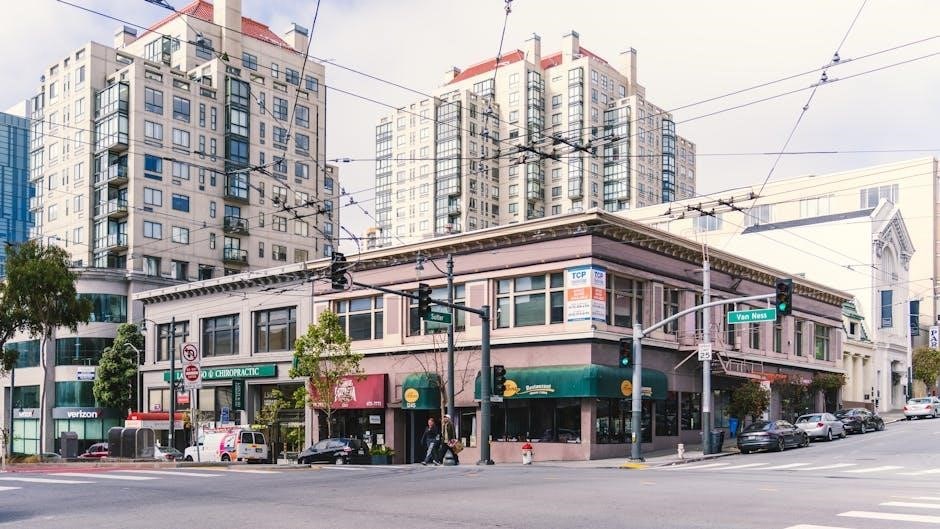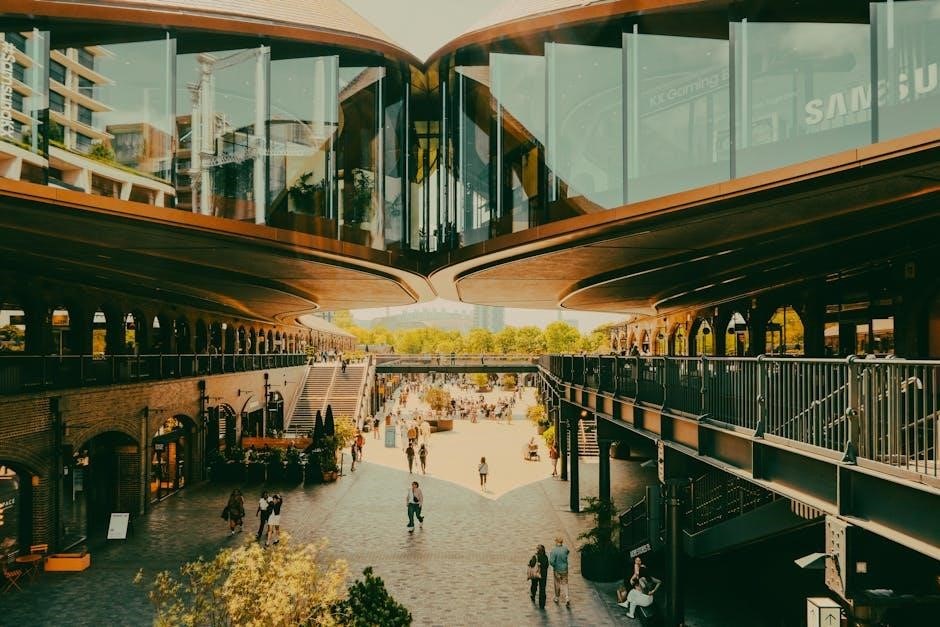Redefining retail explores the transformation of the retail industry‚ driven by technology and shifting consumer behavior.
This section introduces key concepts reshaping retail’s future.
The book provides a comprehensive guide to navigating this change‚ emphasizing innovation‚ customer experience‚ and ethical practices in the evolving retail landscape.
It highlights the importance of adapting to digital advancements and consumer demands for personalized shopping experiences.
1.1 The Evolution of Retail in the Digital Age
Retail has transformed from physical stores to omnichannel experiences‚ driven by digital innovation and shifting consumer preferences.
The rise of e-commerce‚ mobile shopping‚ and social media has reshaped how retailers engage with customers and deliver personalized experiences.
Technologies like AI‚ big data‚ and virtual try-ons are revolutionizing the industry‚ enabling retailers to adapt to evolving demands and create seamless shopping journeys.
This evolution underscores the importance of integrating digital tools to remain competitive in a rapidly changing market.
1.2 Key Challenges Facing Modern Retailers
Modern retailers face challenges like rapid technological changes‚ shifting consumer behaviors‚ and supply chain disruptions.
Adapting to digital transformation while maintaining profitability is crucial‚ as is effectively leveraging customer data to enhance experiences.
Additionally‚ balancing brick-and-mortar stores with e-commerce platforms and addressing sustainability concerns are critical challenges in today’s competitive retail landscape.
These issues require innovative strategies to ensure long-term success and customer loyalty.

The Role of Technology and Analytics in Retail Transformation
Technology drives retail transformation through AI‚ data analytics‚ and digital tools‚ enhancing efficiency‚ personalization‚ and decision-making.
These innovations enable retailers to optimize operations and deliver tailored customer experiences.
By leveraging data‚ retailers gain insights to anticipate trends and improve profitability.
This integration of technology is reshaping the retail industry’s future.
2.1 The Impact of Artificial Intelligence (AI) on Retail
AI revolutionizes retail by automating tasks‚ enhancing personalization‚ and creating human-like interactions.
From chatbots to predictive analytics‚ AI drives efficiency and customer satisfaction.
It enables real-time inventory management and tailored recommendations‚ boosting profitability.
AI-powered tools like virtual try-ons and dynamic pricing further redefine retail experiences.
2.2 Leveraging Data to Enhance Customer Experience
Data analytics plays a pivotal role in enhancing customer experience by providing insights into consumer behavior and preferences.
By embedding data into business operations‚ retailers can offer personalized shopping experiences.
Advanced analytics enable real-time decision-making‚ improving inventory management and customer satisfaction.
This strategic use of data ensures retailers meet evolving demands effectively.

Customer Experience and Personalization
Personalization is revolutionizing retail‚ with AI enabling human-like conversations and tailored shopping experiences;
Customers now expect unique‚ engaging interactions that reflect their preferences and needs.
3.1 The Shift Toward Phygital (Physical + Digital) Retail
Phygital retail merges physical and digital experiences‚ creating seamless shopping environments.
Stores now integrate technologies like virtual try-on and interactive displays to enhance customer engagement.
This approach bridges online and offline worlds‚ offering convenience and immersive brand interactions.
3.2 Using AI to Create Human-like Conversations with Customers
AI-driven chatbots and virtual assistants enable personalized‚ human-like interactions with customers.
These tools analyze data to offer tailored recommendations and resolve queries in real-time.
Such technologies enhance customer satisfaction and streamline communication‚ fostering deeper brand connections.

Sustainability and Ethical Practices in Retail
Sustainability and ethical practices are reshaping retail‚ emphasizing eco-friendly production and fair labor standards.
Consumers increasingly support brands that align profitability with purpose and transparency.
Slow fashion and ethical sourcing are key trends‚ reflecting a broader shift toward responsible retail practices.
4.1 Slow Fashion and Its Influence on Retail Stores
Slow fashion emphasizes sustainable production‚ ethical practices‚ and timeless design‚ challenging the fast fashion model.
It encourages retailers to adopt eco-friendly materials‚ reduce waste‚ and promote fair labor conditions.
This movement is reshaping retail stores by fostering a shift toward quality over quantity‚ influencing consumer behavior and store operations.
By aligning with slow fashion principles‚ retailers can enhance their brand image and appeal to conscious consumers.
This approach not only supports environmental sustainability but also promotes long-term customer loyalty and satisfaction.
4.2 Aligning Business Ethics with Profitability
Aligning business ethics with profitability is crucial for modern retailers‚ fostering trust and loyalty among consumers.
Ethical practices‚ such as transparency and sustainability‚ enhance brand reputation and long-term success.
By prioritizing fair labor practices and environmental responsibility‚ retailers can attract conscious consumers and drive revenue growth.
This approach ensures profitability while contributing positively to society and the planet.

The Future of Retail: Trends and Innovations
The future of retail is shaped by AI‚ virtual try-ons‚ and immersive brand experiences‚ offering personalized and seamless shopping journeys for consumers.
5.1 The Rise of Virtual Try-On Technology
Virtual try-on technology is revolutionizing retail by enabling customers to visualize products on themselves digitally‚ enhancing engagement and reducing returns. This innovation‚ powered by AI and AR‚ provides photorealistic experiences‚ making online shopping more immersive and personalized. Brands like SpreeAI are leading this trend‚ offering solutions that blur the line between physical and virtual shopping‚ creating dynamic customer interactions and boosting satisfaction.
5.2 Transforming Retail Spaces into Immersive Brand Experiences
Retail spaces are evolving into immersive brand experiences‚ blending physical and digital elements to engage customers emotionally. Apple’s stores exemplify this shift‚ creating environments that go beyond shopping. By integrating interactive displays‚ personalized interactions‚ and storytelling‚ retailers craft memorable experiences that foster brand loyalty and differentiate them in a competitive market‚ showcasing the future of retail as a dynamic‚ interactive space.

Global Perspectives on Retail Transformation
Global retail transformation highlights rapid growth in emerging markets like India‚ driven by technology and innovation‚ reshaping the industry’s future worldwide.
6.1 The Growth of Retail in Emerging Markets like India
India’s retail sector has experienced remarkable growth‚ evolving from small‚ family-owned stores to a highly organized industry.
This transformation is driven by urbanization‚ a rising middle class‚ and technological advancements.
E-commerce and digital payments have revolutionized shopping habits‚ blending traditional and modern retail formats.
Sustainability and ethical practices are increasingly influencing consumer preferences‚ shaping the future of retail in India.
The integration of technology and innovation continues to propel this dynamic market forward.
6.2 Case Studies of Successful Retail Innovations Worldwide
Global retailers like Apple and Amazon have set benchmarks with immersive brand experiences and seamless omnichannel strategies.
These innovators leverage AI‚ data analytics‚ and personalized marketing to enhance customer engagement and loyalty.
In Europe‚ brands are adopting sustainability-focused practices‚ while in Asia‚ mobile-first retailing dominates.
These case studies highlight how innovation and adaptability drive success in the evolving retail landscape.
The Role of Payments and Consumer Finance in Retail Evolution
Payments and consumer finance are pivotal in retail evolution‚ driving flexibility and accessibility through innovations like “Buy Now‚ Pay Later” plans and contactless transactions.
7.1 The Rise of “Buy Now‚ Pay Later” Plans
The rise of “Buy Now‚ Pay Later” (BNPL) plans has transformed consumer finance in retail‚ offering flexible payment options that cater to evolving shopper preferences.
These plans‚ gaining traction post-pandemic‚ allow customers to purchase goods with deferred payments‚ reducing upfront financial burden and boosting affordability.
BNPL services are particularly popular among millennials and Gen Z‚ driving higher conversion rates and customer satisfaction for retailers;
This shift reflects changing consumer behavior‚ emphasizing convenience and financial flexibility in the shopping experience.
As a result‚ retailers are increasingly integrating BNPL options to stay competitive and meet modern consumer demands.
7.2 How Payments Are Shaping the Future of Retail
Digital payment methods are revolutionizing retail‚ offering consumers faster‚ more convenient‚ and secure transactions through contactless payments‚ mobile wallets‚ and cryptocurrencies.
These innovations are reshaping shopper expectations‚ driving demand for seamless and intuitive payment experiences that align with modern lifestyles.
The integration of AI and data analytics in payment systems further enhances personalization‚ enabling retailers to offer tailored financial options and improve customer satisfaction.
As payment technologies evolve‚ they are not only simplifying transactions but also fostering deeper connections between retailers and consumers‚ ensuring loyalty and engagement.
Ultimately‚ payments are becoming a cornerstone of retail transformation‚ driving a future where transactions are effortless and deeply integrated into the overall shopping experience.

Practical Strategies for Retailers
Adopting data-driven insights and integrating technology enhances operational efficiency and customer satisfaction‚ ensuring retailers stay competitive in a rapidly evolving market.
8.1 Implementing In-Store Digital Communications
Integrating digital communications in-store enhances customer engagement and streamlines operations. Technologies like digital signage and mobile apps create immersive experiences‚ blending physical and digital interactions. These tools enable real-time product information‚ personalized offers‚ and seamless navigation‚ fostering a connected shopping environment. Retailers can leverage these solutions to boost sales‚ improve customer satisfaction‚ and maintain a competitive edge in a rapidly evolving market.
8.2 Optimizing Supply Chain and Inventory Management
Optimizing supply chain and inventory management is crucial for retail efficiency. Advanced technologies like AI and data analytics enable precise demand forecasting‚ reducing stockouts and overstocking. Automation streamlines order fulfillment‚ ensuring seamless inventory tracking. These innovations enhance operational agility‚ minimize costs‚ and improve customer satisfaction by aligning inventory with real-time demand‚ fostering a more responsive and resilient retail ecosystem.
Redefining retail demands continuous innovation and adaptability. Retailers must embrace technology and ethical practices to meet evolving consumer demands and thrive in a competitive landscape.
9.1 The Need for Continuous Innovation in Retail
Continuous innovation is crucial for retailers to stay competitive in a rapidly evolving market. Technology‚ such as AI and data analytics‚ drives transformative changes in customer experiences and operational efficiency. Retailers must adapt to emerging trends like virtual try-on technology and sustainable practices to meet shifting consumer demands. Innovation ensures businesses remain relevant and resilient in the face of disruption‚ fostering long-term growth and success.
9.2 Empowering Retailers to Embrace the Future
Empowering retailers involves equipping them with tools and strategies to thrive in a dynamic environment. By leveraging technology‚ data‚ and ethical practices‚ businesses can enhance customer experiences and operational efficiency. Retailers must adopt a mindset of continuous learning and adaptation‚ prioritizing innovation and sustainability. This empowerment enables them to not only survive but lead in the evolving retail landscape‚ ensuring profitability and relevance for years to come.




